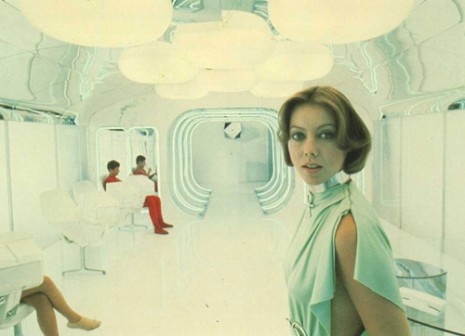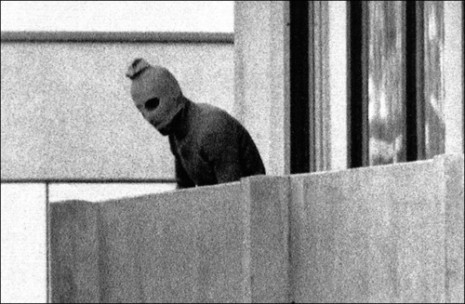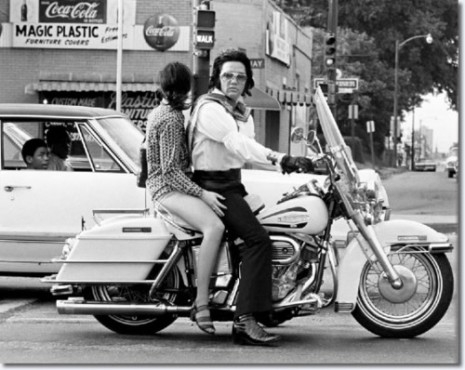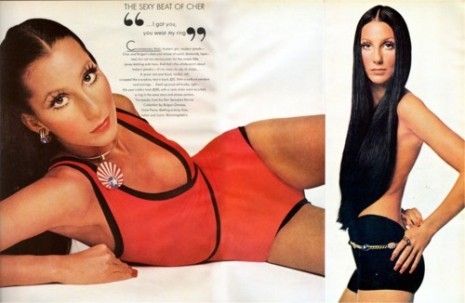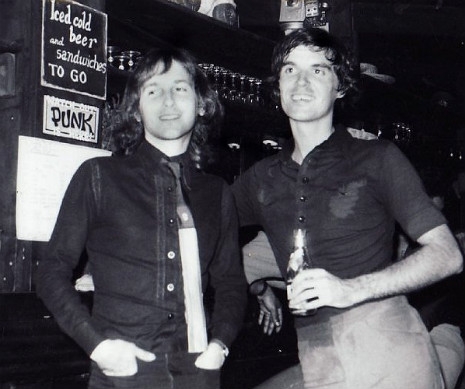
Jeff Salen of Tuff Darts and Talking Heads’ David Byrne at CBGB, 1976. Photo: Robert Spencer.
It has been said that when a city is in decline the arts flourish. I don’t know who said it or when it was said or if anyone actually said it at all. It’s one of those things that sounds true and feels true and when I say it people tend to agree, whether it’s true or not. It certainly seemed true when I arrived with my band in New York City in 1977 to play a Monday night gig at CBGB.
Crawling out of an Econoline van into the humidly dense New York night and having a fistful of Bowery cesspool stench sucker punch me was like being greeted by a Welcome Wagon full of decaying dog dicks. I liked it. I took in a lungful of the jaundiced air and knew immediately that my Muse was there somewhere…stuck like a moth in the viscous Manhattan murk.
The asshole smell of downtown NYC was exactly the kind of reality check I needed after spending six years languishing at the foot of the Rocky Mountains in Boulder, Colorado. I had arrived in 1970s Manhattan ready to have my world dismembered like a frog in anatomy class. I offered my neck to the city’s rusty scalpel with only a bottle of Jack Daniel’s and a bindle of blow to deaden the pain. 25 years later, I came out of surgery a changed man. And I have the scars to prove it. Lovely scars that you can count to determine my age.
In the first few years of living in NYC, I spent most my nights hanging at Max’s, CBGB, Danceteria, The Peppermint Lounge, The Mudd Club, Hurrah’s and countless other clubs soaking in the glorious sounds of local bands like The Patti Smith Group, The Ramones, Blondie, Talking Heads, Suicide, Tuff Darts, Mink DeVille, The Contortions, Steel Tips, The Dictators, The Mumps… many of whom were gaining international reputations for rescuing rock and roll from the corporate death grip of a dying music industry and from its own artistic stagnation. This was not a commercial strategy, it was something closer to a collective religious epiphany. Poets, painters and philosophers were adding guitars and amplifiers to their arsenals of typewriters, journals and canvas to further expand their medium of self-expression and resurrect a pop culture that had shot its wad at the tail end of the Sixties.
While my main interest was with what was happening in the punk clubs, there were major musical tremors snaking throughout Manhattan,The Bronx and Spanish Harlem. Jazz, rap, disco and Latin music were all drawing from some deep well of inspiration in a city that, on the surface, seemed to be collapsing in on itself. The economy, infrastructure and racial division were crushing Gotham like Godzilla-sized pigeons with restless leg syndrome.
Darkness breeds light and pockets of artists, of every color and cultural background, were conjuring all kinds of magic. And the magic was converging and intermingling in a melting pot, a Hessian crucible, in which alchemical beats, rhythms and song were being transmuted into healing vibrations balancing Gotham’s gloomy Kali Yuga yang into Shakti-powered yin transforming the tortured cries of the city into ecstatic utterance you could dance to, fuck to and get high to. Music was the wave that kept the city from tanking. As the garbage piled up on the streets and triumphant rats were raising flags on mounds of rotting debris like rodent versions of the Marines ascending Iwo Jima, glittering disco balls gaily revolved like tin foil prayer wheels in Studio 54 and downtown The Ramones were generating more energy on the Bowery than Con Edison and the psychotic barker from the Crazy Eddie commercials combined. Music provided the make-up, the blush and mascara that gave New York City the appearance of still being alive.
Will Hermes’ exhilarating new book Love Goes To Buildings On Fire: Five Years In New York That Changed Music Forever captures the energy and excitement of New York’s music scene from 1973 to 1978 in all its multitudinous forms. It is richly detailed, never dull, and exhaustively researched. I came to the book knowing most of what there is to know about Manhattan’s punk scene and as someone who was there at the time was pleased to see that Hermes (who was also there) manages to make it all come alive again. This is not a dull slog through familiar turf. Herme’s prose pulses with a rock and roll heart. He loves what he’s writing about. And he’s writing about much more than just what falls within my frame of reference. He sees and connects dots between various scenes creating a kind of musical mandala. From the lofts of downtown avant-garde jazz composers like Philip Glass to the South Bronx and the roots of rap with Kool Herc to disco’s inception spun off the turntables of Nicky Siano to The Fania All-Stars’ explosive sets at the Cheetah Club, Hermes is like a human Google map, giving us the God’s eye view and zooming in right down to the graffiti in the bathroom.
Today, things seems as bleak as they did in New York City during the 1970s. There’s a sense of hopelessness, a sense that things are getting out of control. But underneath the despair there is a subway-like rumbling, a rhythm, a beat, a sensation that something is moving and about to surface and it could be a train entering the station or it could be something like music, something pulling us all together in a movement that thrusts forward into the future and will not be denied. I’ve seen what the power of music can do. I saw it in the Sixties and I saw it again in the Seventies. And right now my eyes are wide open and ready to see it again.
Love Goes To Buildings On Fire is that fine kind of book that takes you backwards and forward at the same time. Will Hermes reminds us that music matters and every revolution, every movement, every cultural and political upheaval, creates its own soundtrack. What will ours be this time around?
Here’s a video mix inspired by Will’s book which includes some seminal songs that came out of New York City in the 1970s.
1. “Jet Boy” - The New York Dolls 2. “Piss Factory” - Patti Smith 3. “X-Offender” Blondie 4. “Born To Lose” - The Heartbreakers 5. “SuperRappin’” - Grandmaster Flash 6. “Darrio” - Kid Creole 7. “The Mexican” - Babe Ruth 8. “Pop Your Funk” - Arthur Russell






